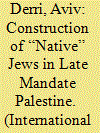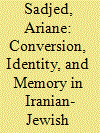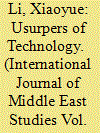|
|
|
Sort Order |
|
|
|
Items / Page
|
|
|
|
|
|
|
| Srl | Item |
| 1 |
ID:
179850


|
|
|
|
|
| Summary/Abstract |
This article concerns the place of late Ottoman Jews in Palestine on the eve of the 1948 War. It focuses on Israel Ben-Zeʾev (Wolfensohn), a Jerusalem-born educator and Nahda intellectual who led a movement of self-identified “native” Jews, including both “Old Yishuv” Ashkenazim and Sephardim, to combat their marginalization by the Zionist institutions. I examine his lifetime struggle to advance the study of Arabic and “Arab Jews” (yahud ʿarab) under early Islam by creating institutions of knowledge production and educational programs modeled on those he knew from his early academic career in Cairo. It was in the context of these struggles that demands for separate political representation for native Jews and for a specialized field of Arab Jewish studies coalesced as part of a broader project of a shared Arab-Jewish cultural modernization. They culminated in 1948, when Ben-Zeʾev finally realized his Arabic library project, ironically using looted Palestinian books, only to see its destruction four years later by Zionist leaders and Hebrew University professors.
|
|
|
|
|
|
|
|
|
|
|
|
|
|
|
|
| 2 |
ID:
179849


|
|
|
|
|
| Summary/Abstract |
The paper discusses the narratives of Jews from Mashhad, who were forced to convert to Islam in 1839. The community narrative as well as academic research is dominated by a modern understanding of religious identity and religious boundaries that fail to account for the diversity of practices among the community of converts, including multiple forms of religious belonging, and the switching of identities according to time and place. Based on historical sources and interviews with descendants from the Mashhadi community, the paper traces how a particular narrative of the history of the Jews from Mashhad prevailed and which significance this narrative entails for Mashhadi community and identity until today. While the Jews from Mashhad are a rather unique case among Iranian Jews–due to the long period in which they lived as converts–their pattern of memory building reflects a general trend among Jews from the Muslim world to assimilate to modern ideas of being Jewish.
|
|
|
|
|
|
|
|
|
|
|
|
|
|
|
|
| 3 |
ID:
179846


|
|
|
|
|
| Summary/Abstract |
Coronations are commonly held at the beginning of a monarch's reign, symbolizing accession to the throne and the continuation of the dynasty. Mohammad Reza Pahlavi's coronation ceremony of 1967, however, was held twenty-six years into his rule and was designed to draw attention to the renewed glory of Iranian monarchy and the successes of the Pahlavi shahs. This coronation ceremony and related events offer important insights into the Pahlavi ideologues’ conceptualization of monarchy and the strategies they employed to inculcate their ideology in a domestic and global audience. The shah and the monarchy were presented as revolutionary and reformist, and simultaneously as the ultimate defenders of tradition; as religious by nature, but also as proponents of the separation of church and state. This paper seeks to understand, using a range of underutilized primary source material, how the regime delivered these apparently contradictory notions, and what it sought to gain from holding the event in the way that it did.
|
|
|
|
|
|
|
|
|
|
|
|
|
|
|
|
| 4 |
ID:
179852


|
|
|
|
|
| Summary/Abstract |
When Joel Gordon, the editor of the International Journal of Middle East Studies, asked me to reexamine a notable classic book in my field of North African history, I immediately thought of one that I had reviewed favorably forty-one years ago, Abdallah Laroui's The History of the Maghrib. The book is a seminal work of historical synthesis, by one of the most eminent living Maghribi scholars. It remains relevant today.
|
|
|
|
|
|
|
|
|
|
|
|
|
|
|
|
| 5 |
ID:
179848


|
|
|
|
|
| Summary/Abstract |
This article considers the celebrated elegy by the classical 7th-century Arabic poet, Abu Dhuʾayb al-Hudhali — his ʿayniyya, which ends with ʿayn as a rhyming letter. Analyzing the poem's structure and comparing it with that of two poems composed by Abu Dhuʾayb's teacher, Saʿida b. Juʾayya al-Hudhali, leads to the conclusion that Saʿida's two poems were the main sources on which the pupil drew to create his poem. The sophisticated changes that Abu Dhuʾayb introduced in structure and content, however, made his poem more memorable than those of his teacher. The article raises another question, to which there is, as yet, no definitive answer: what was the true inspiration for Abu Dhuʾayb's poem? Was it the death of his sons, as is traditionally believed, or was it literary: to surpass his teacher in composing a more skillful poem?
|
|
|
|
|
|
|
|
|
|
|
|
|
|
|
|
| 6 |
ID:
179851


|
|
|
|
|
| Summary/Abstract |
This article explores the way overland mobility was transformed in the late 19th and early 20th centuries, during “the age of speed.” Beyond the already well-known caravan-to-car story, it argues that slow means of transportation such as caravans kept their own rationale and were instrumental in producing an economic geography that proved resilient in the face of the celebrated steam- or fuel-motorized means of accelerated mobility. Adopting the caravan traders and travelers’ vantage and foregrounding their life stories offer new insights on the way rail and automobility were experienced and adopted in the post-Ottoman Middle East. Such experiences cast a different light on the global rechanneling process affecting the circulation of persons and merchandise across the region during the interwar period. Exploring the resilience of caravans in an uneven age of speed does not only illuminate the transnational geographies underpinned by the overlapping networks of both slower and faster mobilities. It also helps to understand the many dimensions of their gradual albeit very uneven demise.
|
|
|
|
|
|
|
|
|
|
|
|
|
|
|
|
| 7 |
ID:
179847


|
|
|
|
|
| Summary/Abstract |
This article examines banditry, embezzlement, and other insider crimes along Egyptian railway lines during a period when British officials exerted centralized control over the Egyptian railway and financial austerity had a negative impact on the rail sector. By exploring the motives and tactics of railway crimes, I posit that criminals, by making claims on and use of the technology outside the purview of state regulations, expressed their heterogeneous desires to redistribute social wealth, repurpose the technological promise of modern railways, and confound intentions of colonial governance. Using new archival materials, this article utilizes a bottom-up approach to examine grassroots activism, everyday knowledge, informal networks, and the social mores and norms that criminals harnessed to discern infrastructural vulnerabilities and elude surveillance from the colonial state. Ultimately, I contend that criminal acts uncovered social crises otherwise hidden under the shadow of the exterior prosperity and stability of late 19th-century Egypt.
|
|
|
|
|
|
|
|
|
|
|
|
|
|
|
|
|
|
|
|
|